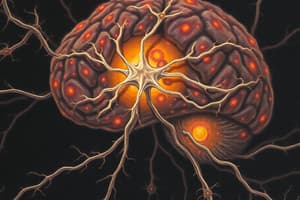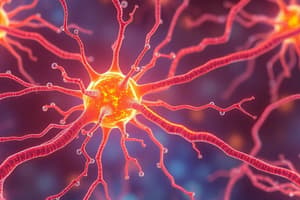Podcast
Questions and Answers
ഒരു വ്യക്തിക്ക് ഒരു അപകടത്തെ തുടർന്ന് parietal lobe-ന് കേടുപാടുകൾ സംഭവിച്ചാൽ താഴെ പറയുന്നവയിൽ ഏത് പ്രവർത്തനത്തിനാണ് വൈകല്യം സംഭവിക്കാൻ സാധ്യത?
ഒരു വ്യക്തിക്ക് ഒരു അപകടത്തെ തുടർന്ന് parietal lobe-ന് കേടുപാടുകൾ സംഭവിച്ചാൽ താഴെ പറയുന്നവയിൽ ഏത് പ്രവർത്തനത്തിനാണ് വൈകല്യം സംഭവിക്കാൻ സാധ്യത?
- കാഴ്ച ശക്തി
- ഗന്ധം അറിയാനുള്ള കഴിവ്
- കേൾവി ശക്തി
- സ്പർശനശേഷി (correct)
താഴെ പറയുന്നവയിൽ ഏതാണ് central nervous system-ൻ്റെ ഭാഗമല്ലാത്തത്?
താഴെ പറയുന്നവയിൽ ഏതാണ് central nervous system-ൻ്റെ ഭാഗമല്ലാത്തത്?
- സുഷുമ്നാ നാഡി
- ഗാംഗ്ലിയ (correct)
- ബ്രെയിൻ സ്റ്റെം
- തലച്ചോറ്
താഴെ പറയുന്നവയിൽ ഏതാണ് voluntary movements നിയന്ത്രിക്കുന്നത്?
താഴെ പറയുന്നവയിൽ ഏതാണ് voluntary movements നിയന്ത്രിക്കുന്നത്?
- Sympathetic division
- Somatic nervous system (correct)
- Parasympathetic division
- Autonomic nervous system
രണ്ട് cerebral hemispheres-നെയും തമ്മിൽ ബന്ധിപ്പിക്കുന്ന structure ഏതാണ്?
രണ്ട് cerebral hemispheres-നെയും തമ്മിൽ ബന്ധിപ്പിക്കുന്ന structure ഏതാണ്?
ഒരു ന്യൂറോണിന്റെ ഏത് ഭാഗമാണ് action potential ഉത്പാദിപ്പിക്കുന്നത്?
ഒരു ന്യൂറോണിന്റെ ഏത് ഭാഗമാണ് action potential ഉത്പാദിപ്പിക്കുന്നത്?
താഴെ പറയുന്നവയിൽ ഏതാണ് cerebellum-ൻ്റെ പ്രധാന કાર્યങ്ങളിൽ ഒന്ന്?
താഴെ പറയുന്നവയിൽ ഏതാണ് cerebellum-ൻ്റെ പ്രധാന કાર્યങ്ങളിൽ ഒന്ന്?
താഴെ പറയുന്നവയിൽ ഏതാണ് 'rest and digest' പ്രവർത്തനങ്ങളെ നിയന്ത്രിക്കുന്നത്?
താഴെ പറയുന്നവയിൽ ഏതാണ് 'rest and digest' പ്രവർത്തനങ്ങളെ നിയന്ത്രിക്കുന്നത്?
തലച്ചോറിലെ ഏത് ഭാഗമാണ് വിശപ്പ്, ദാഹം, ശരീരത്തിലെ താപനില എന്നിവ നിയന്ത്രിക്കുന്നത്?
തലച്ചോറിലെ ഏത് ഭാഗമാണ് വിശപ്പ്, ദാഹം, ശരീരത്തിലെ താപനില എന്നിവ നിയന്ത്രിക്കുന്നത്?
താഴെ പറയുന്നവയിൽ ഏത് glial cell ആണ് myelin sheath ഉണ്ടാക്കുന്നത്?
താഴെ പറയുന്നവയിൽ ഏത് glial cell ആണ് myelin sheath ഉണ്ടാക്കുന്നത്?
ഒരു വ്യക്തിക്ക് Wernicke's area-യിൽ ക്ഷതം സംഭവിച്ചാൽ ഏത് કાર્યത്തിനാണ് ബുദ്ധിമുട്ടുണ്ടാവുക?
ഒരു വ്യക്തിക്ക് Wernicke's area-യിൽ ക്ഷതം സംഭവിച്ചാൽ ഏത് કાર્યത്തിനാണ് ബുദ്ധിമുട്ടുണ്ടാവുക?
Synaptic transmission-ൽ neurotransmitters എവിടെ നിന്നാണ് విడుదల ചെയ്യുന്നത്?
Synaptic transmission-ൽ neurotransmitters എവിടെ നിന്നാണ് విడుదల ചെയ്യുന്നത്?
താഴെ പറയുന്നവയിൽ ഏതാണ് തലച്ചോറിൻ്റെ visual processing center?
താഴെ പറയുന്നവയിൽ ഏതാണ് തലച്ചോറിൻ്റെ visual processing center?
തലാമസിൻ്റെ (Thalamus) പ്രധാന ധർമ്മം എന്താണ്?
തലാമസിൻ്റെ (Thalamus) പ്രധാന ധർമ്മം എന്താണ്?
താഴെ പറയുന്നവയിൽ ഏതാണ് central nervous system-ത്തിലെ immune cell?
താഴെ പറയുന്നവയിൽ ഏതാണ് central nervous system-ത്തിലെ immune cell?
Parkinson's disease-ൽ ഏത് neurotransmitter-ൻ്റെ കുറവാണ് കാണുന്നത്?
Parkinson's disease-ൽ ഏത് neurotransmitter-ൻ്റെ കുറവാണ് കാണുന്നത്?
Medulla oblongata-യുടെ പ്രധാന കർത്തവ്യം എന്താണ്?
Medulla oblongata-യുടെ പ്രധാന കർത്തവ്യം എന്താണ്?
താഴെ പറയുന്നവയിൽ ഏതാണ് brain plasticity-ക്ക് ഒരു ഉദാഹരണം?
താഴെ പറയുന്നവയിൽ ഏതാണ് brain plasticity-ക്ക് ഒരു ഉദാഹരണം?
താഴെ പറയുന്നവയിൽ ഏതാണ് sympathetic nervous system-ൻ്റെ പ്രവർത്തനം?
താഴെ പറയുന്നവയിൽ ഏതാണ് sympathetic nervous system-ൻ്റെ പ്രവർത്തനം?
ഒരു ന്യൂറോണിന്റെ dendrites-ൻ്റെ പ്രധാന ധർമ്മം എന്താണ്?
ഒരു ന്യൂറോണിന്റെ dendrites-ൻ്റെ പ്രധാന ധർമ്മം എന്താണ്?
Alzheimer's disease-ൽ പ്രധാനമായി ഏത് brain region-നാണ് നാശം സംഭവിക്കുന്നത്?
Alzheimer's disease-ൽ പ്രധാനമായി ഏത് brain region-നാണ് നാശം സംഭവിക്കുന്നത്?
Flashcards
നാഡീവ്യൂഹം
നാഡീവ്യൂഹം
ശരീരത്തിലെ വൈദ്യുത, രാസ സിഗ്നലുകളെ സംക്രമിപ്പിക്കുന്ന കോശങ്ങളുടെ ഒരു സങ്കീർണ്ണ ശൃംഖല.
ന്യൂറോണുകൾ
ന്യൂറോണുകൾ
നാഡീവ്യൂഹത്തിന്റെ അടിസ്ഥാന ഘടകങ്ങൾ. വിവരങ്ങൾ കൈമാറാൻ പ്രത്യേകമായി രൂപകൽപ്പന ചെയ്തിട്ടുള്ളവ ന്യൂറോണുകളാണ്.
ഗ്ലിയൽ കോശങ്ങൾ
ഗ്ലിയൽ കോശങ്ങൾ
ആസ്ട്രോസൈറ്റുകൾ ന്യൂറോണുകൾക്ക് പോഷകങ്ങൾ നൽകുകയും പിന്തുണയ്ക്കുകയും ചെയ്യുന്നു, കൂടാതെ രാസപരമായ ചുറ്റുപാട് നിയന്ത്രിക്കുകയും രക്ത-മസ്തിഷ്ക തടസ്സത്തിന് സഹായിക്കുകയും ചെയ്യുന്നു.
കേന്ദ്ര നാഡീവ്യൂഹം (CNS)
കേന്ദ്ര നാഡീവ്യൂഹം (CNS)
Signup and view all the flashcards
പെരിഫറൽ നാഡീവ്യൂഹം (PNS)
പെരിഫറൽ നാഡീവ്യൂഹം (PNS)
Signup and view all the flashcards
തലച്ചോറ്
തലച്ചോറ്
Signup and view all the flashcards
സുഷുമ്നാ നാഡി
സുഷുമ്നാ നാഡി
Signup and view all the flashcards
ഫ്രന്റൽ ലോബ്
ഫ്രന്റൽ ലോബ്
Signup and view all the flashcards
പാരിറ്റൽ ലോബ്
പാരിറ്റൽ ലോബ്
Signup and view all the flashcards
ടെമ്പറൽ ലോബ്
ടെമ്പറൽ ലോബ്
Signup and view all the flashcards
ഒസിപിറ്റൽ ലോബ്
ഒസിപിറ്റൽ ലോബ്
Signup and view all the flashcards
ഡൈൻസ്ഫലോൺ
ഡൈൻസ്ഫലോൺ
Signup and view all the flashcards
തലാമസ്
തലാമസ്
Signup and view all the flashcards
ഹൈപ്പോതലാമസ്
ഹൈപ്പോതലാമസ്
Signup and view all the flashcards
ബ്രെയിൻ സ്റ്റെം
ബ്രെയിൻ സ്റ്റെം
Signup and view all the flashcards
മെഡുള്ള ഒബ്ലോംഗറ്റ
മെഡുള്ള ഒബ്ലോംഗറ്റ
Signup and view all the flashcards
സെറിബെల్లം
സെറിബെల్లം
Signup and view all the flashcards
ആക്ഷൻ പൊട്ടൻഷ്യൽ
ആക്ഷൻ പൊട്ടൻഷ്യൽ
Signup and view all the flashcards
ന്യൂറോട്രാൻസ്മിറ്ററുകൾ
ന്യൂറോട്രാൻസ്മിറ്ററുകൾ
Signup and view all the flashcards
ന്യൂറോപ്ലാസ്റ്റിസിറ്റി
ന്യൂറോപ്ലാസ്റ്റിസിറ്റി
Signup and view all the flashcards
Study Notes
- The nervous system is a complex network of cells that transmits electrical and chemical signals throughout the body.
- It is responsible for coordinating and regulating bodily functions, as well as enabling sensation, movement, and cognition.
Cells of the Nervous System
- Neurons are the fundamental units of the nervous system, specialized for transmitting information. Glial cells provide support and protection for neurons.
Neurons
- Neurons transmit signals via electrical impulses called action potentials.
- They have a cell body (soma), dendrites (which receive signals), and an axon (which transmits signals).
- Communication between neurons occurs at synapses through the release of neurotransmitters.
Glial Cells
- Astrocytes provide nutrients and support to neurons, regulate the chemical environment, and contribute to the blood-brain barrier.
- Oligodendrocytes (in the central nervous system) and Schwann cells (in the peripheral nervous system) form myelin sheaths around axons, increasing the speed of signal transmission.
- Microglia act as immune cells in the brain, removing debris and protecting against pathogens.
Organization of the Nervous System
- The nervous system is divided into the central nervous system (CNS) and the peripheral nervous system (PNS).
Central Nervous System (CNS)
- The CNS includes the brain and the spinal cord.
- The brain is the control center of the body, responsible for higher-level functions such as thought, memory, emotion, and language.
- The spinal cord transmits signals between the brain and the rest of the body and mediates reflexes.
Peripheral Nervous System (PNS)
- The PNS consists of nerves and ganglia outside of the brain and spinal cord.
- It is divided into the somatic nervous system (controls voluntary movements) and the autonomic nervous system (controls involuntary functions).
- The autonomic nervous system is further divided into the sympathetic (fight-or-flight) and parasympathetic (rest-and-digest) divisions.
Brain Structure and Function
- The brain is a complex organ with distinct regions, each responsible for specific functions.
- Key brain regions include the cerebrum, diencephalon, brainstem, and cerebellum.
Cerebrum
- The cerebrum is the largest part of the brain, divided into two hemispheres (left and right).
- Each hemisphere is further divided into four lobes: frontal, parietal, temporal, and occipital.
Frontal Lobe
- Responsible for higher cognitive functions such as planning, decision-making, working memory, and language (Broca's area).
- It also controls voluntary movements (motor cortex).
Parietal Lobe
- Processes sensory information such as touch, temperature, pain, and spatial awareness.
- It is involved in integrating sensory and motor information.
Temporal Lobe
- Involved in auditory processing, memory formation, and language comprehension (Wernicke's area).
- It also plays a role in object recognition and emotional responses.
Occipital Lobe
- Primarily responsible for visual processing.
- It receives and interprets information from the eyes.
Diencephalon
- Located beneath the cerebrum.
- Contains the thalamus and hypothalamus.
Thalamus
- Acts as a relay station for sensory information, transmitting signals to the cerebral cortex.
- It also plays a role in regulating sleep, alertness, and consciousness.
Hypothalamus
- Regulates body temperature, hunger, thirst, sleep-wake cycles, and hormone release.
- It connects the nervous system to the endocrine system via the pituitary gland.
Brainstem
- Connects the brain to the spinal cord.
- Consists of the midbrain, pons, and medulla oblongata.
Midbrain
- Involved in motor control, vision, hearing, and sleep-wake cycles.
Pons
- Relays signals between the cerebrum and cerebellum.
- It is involved in regulating sleep, respiration, and swallowing.
Medulla Oblongata
- Controls vital functions such as heart rate, blood pressure, and breathing.
- It also mediates reflexes such as vomiting, coughing, and sneezing.
Cerebellum
- Located at the back of the brain.
- Coordinates movement, balance, and posture.
- It also plays a role in motor learning and cognitive functions.
Neural Communication
- Neurons communicate with each other through electrical and chemical signals.
Action Potentials
- Action potentials are rapid changes in the electrical potential across the neuron's membrane.
- They are triggered when the neuron reaches a threshold potential.
- Action potentials travel down the axon to the synapse.
Synaptic Transmission
- At the synapse, the action potential triggers the release of neurotransmitters from the presynaptic neuron.
- Neurotransmitters bind to receptors on the postsynaptic neuron, causing a change in its membrane potential.
- This can either excite (depolarize) or inhibit (hyperpolarize) the postsynaptic neuron.
Neurotransmitters
- Neurotransmitters are chemical messengers that transmit signals between neurons.
- Examples include acetylcholine, dopamine, serotonin, norepinephrine, glutamate, and GABA.
- Each neurotransmitter has specific receptors and effects on the postsynaptic neuron.
Neuroplasticity
- Neuroplasticity is the brain's ability to change and adapt in response to experience.
- It involves changes in the strength of synaptic connections, as well as the formation of new synapses and neurons.
- Neuroplasticity is essential for learning, memory, and recovery from brain injury.
Development of the Nervous System
- The nervous system develops in a series of stages, starting with the formation of the neural tube in the embryo.
Neural Tube Formation
- The neural tube gives rise to the brain and spinal cord.
- Neurons and glial cells proliferate, migrate, and differentiate into specialized cell types.
Synaptogenesis
- Synapses form between neurons, and neural circuits are established.
- Synaptic connections are refined through activity-dependent mechanisms.
Myelination
- Myelin sheaths form around axons, increasing the speed of signal transmission.
- Myelination continues throughout childhood and adolescence.
Disorders of the Nervous System
- Many disorders can affect the nervous system, including neurological disorders, psychiatric disorders, and neurodevelopmental disorders.
Neurological Disorders
- Examples include stroke, epilepsy, Parkinson's disease, Alzheimer's disease, and multiple sclerosis.
- These disorders can result from genetic factors, environmental factors, or injury to the brain or spinal cord.
Psychiatric Disorders
- Examples include depression, anxiety disorders, schizophrenia, and bipolar disorder.
- These disorders are thought to involve imbalances in neurotransmitter systems or abnormalities in brain structure or function.
Neurodevelopmental Disorders
- Examples include autism spectrum disorder, attention-deficit/hyperactivity disorder (ADHD), and intellectual disability.
- These disorders result from abnormalities in brain development that can affect cognition, behavior, and social functioning.
Studying That Suits You
Use AI to generate personalized quizzes and flashcards to suit your learning preferences.





